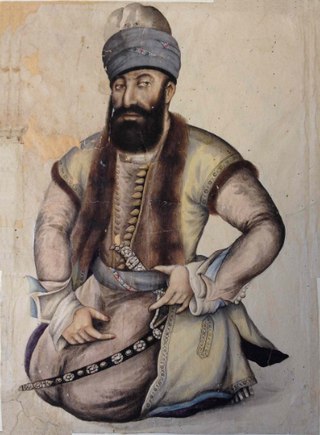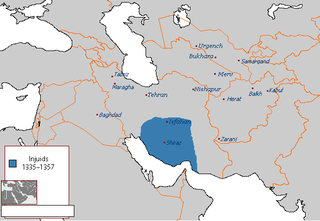This article needs additional citations for verification .(January 2013) |

Shah Mansur was the last of the Muzaffarid rulers of Southern Iran. He ruled from Isfahan and was killed by the forces of Timur in 29 March 1393. [1]
This article needs additional citations for verification .(January 2013) |

Shah Mansur was the last of the Muzaffarid rulers of Southern Iran. He ruled from Isfahan and was killed by the forces of Timur in 29 March 1393. [1]
Mansur was the brother of Shah Yahya and Shah Hosein. His uncle was Shah Shoja, with whom he fought against in battle. [2] : 41
With support from the Jalayirid Sultanate, Mansur established himself as an independent ruler in Shushtar. [2] : 41
Mansur's grave is located in the eastern part of Shiraz, in an area known as Gowd-e-Shahzadeh (Prince Mansur's Tomb). [2] : 43

Khwāje Shams-od-Dīn Moḥammad Ḥāfeẓ-e Shīrāzī, known by his pen name Hafez or Hafiz, was a Persian lyric poet whose collected works are regarded by many Iranians as one of the highest pinnacles of Persian literature. His works are often found in the homes of Persian speakers, who learn his poems by heart and use them as everyday proverbs and sayings. His life and poems have become the subjects of much analysis, commentary, and interpretation, influencing post-14th century Persian writing more than any other Persian author.

Mohammad Karim Khan Zand was the founder of the Zand Dynasty, ruling from 1751 to 1779. He ruled all of Iran (Persia) except for Khorasan. He also ruled over some of the Caucasian lands and occupied Basra for some years.

The Muzaffarid dynasty was a Muslim dynasty which came to power in Iran following the breakup of the Ilkhanate in the 14th century. At their zenith, they ruled a kingdom comprising Iranian Azerbaijan, Central Persia, and Persian Iraq. The Muzaffarids were known for their support of Arabic literature. Shah Shoja was a poet and wrote in both Arabic and Persian and was said to be capable of memorizing eight verses of Arabic poetry after hearing them read once. While the Muzaffarid ruler of Kirman, Shah Yahya, commissioned the scholar Junyad bin Mahmud Al-Umari to compile an anthology of Arabic poetry and prose for him

Khwajeh Nizam al-Din Ubayd Allah al-Zakani, better known as Ubayd Zakani, was a Persian poet of the Mongol era, regarded as one of the best satirists in Persian literature. His most famous work is Mush-o Gorbeh, a political satire which attacks religious hypocrisy. Although a highly popular figure in his own time, Ubayd's work received little attention from modern scholars until recently, due to provocative and bawdy texts in the majority of his works. His style of satire has been compared to the French Enlightenment writer Voltaire.

The Injuids were an Iranian dynasty of Persian origin that came to rule over the cities of Shiraz and Isfahan during the 14th century. Its members became de facto independent rulers following the breakup of the Ilkhanate until their defeat in 1357.

Shaykh Uways Jalayir was the Jalayirid ruler of Iraq (1356–1374) and Azerbaijan (1360–1374). He was the son of Hasan Buzurg and the Chobanid princess Dilshad Khatun.

Abu Nasr Khusrau Firuz, better known by his laqab of Al-Malik al-Rahim was the last Buyid amir of Iraq. He was the son of Abu Kalijar.

The Jalayirid Sultanate was a Mongol Jalayir dynasty which ruled over modern-day Iraq and western Iran after the breakup of the Mongol khanate of Persia in the 1330s. It lasted about fifty years, until disrupted by Timur's conquests and the revolts of the Qara Qoyunlu Turkoman. After Timur's death in 1405, there was a brief attempt to re-establish the sultanate in southern Iraq and Khuzistan. The Jalayirids were finally eliminated by the Qara Qoyunlu in 1432.

Sadeq Khan Zand, also known as Mohammad Sadeq, was the fourth Shah of the Zand dynasty of Iran from August 22, 1779 until March 14, 1781.

Ali-qoli Khan, commonly known by his regnal title Adel Shah was the second shah of Afsharid Iran, ruling from 1747 to 1748. He was the nephew and successor of Nader Shah, the founder of the Afsharid dynasty.

Shah Shoja, was the ruler of the Mozaffarids from 1358 to 1384. He was the son and successor of Mubariz al-Din Muhammad. During the lengthy reign of Shah Shoja, his kingdom reached its zenith of power, stretching from Balochistan to Arran.
Abu Mansur Fulad Sutun was the last Buyid amir of Fars, ruling more or less continuously from 1048 until his death. He was the son of Abu Kalijar.

The Marashiyan or Marashis were an Iranian Sayyid Twelver Shiʿite dynasty of Mazandarani origin, ruling in Mazandaran from 1359 to 1596. The dynasty was founded by Mir-i Buzurg, a Sayyid native to Dabudasht. Their capitals were Amol, Sari, and Vatashan.

The Salghurids, also known as the Atabegs of Fars, were a Persianate dynasty of Salur Turkoman origin that ruled Fars, first as vassals of the Seljuks then for the Khwarazm Shahs in the 13th century.
Abu Sa'd Khusrau Shah, was the Buyid amir of Fars. He was the son of Abu Kalijar.

Mubariz al-Din Muhammad, was the founder of the Muzaffarid dynasty, ruling from 1314 to 1358. He was born to a family of Persians with distant Arab origin, which settled in Khurasan during the Islamic conquest. He was the son of Sharaf al-Din Muzaffar, a servant of the Ilkhanids and on his father's death in 1314 Mubariz inherited his father's offices.

Abu Torab, better known by his dynastic name of Ismail III (اسماعیل), was a Safavid prince, who reigned as a figurehead under the authority of Ali Mardan Khan Bakhtiari briefly from 1750 to 1751, and then under the Zand ruler Karim Khan Zand from 1751 till his death in 1773.
Hossein Qoli Khan Qajar was the Qajar chieftain of the Qoyunlu branch from 1759 till his death in 1777 and brother of the founder of the Qajar dynasty of Iran Agha Mohammad Khan Qajar.

Abu Ishaq Inju was the last Injuid ruler from 1343 to 1357. During his reign the city of Shiraz flourished, consisting of prominent figures such as Hafez, Khwaju Kermani and Ubayd Zakani. In 1357, the Muzaffarid ruler Mubariz al-Din Muhammad captured Shiraz, and had Abu Ishaq Inju executed.